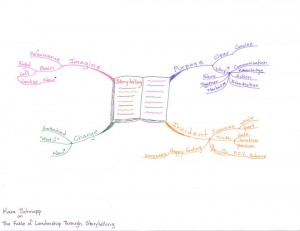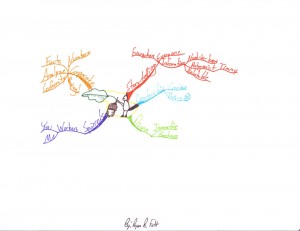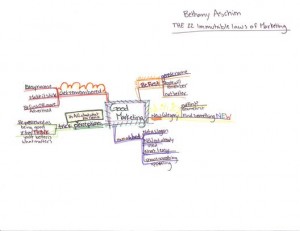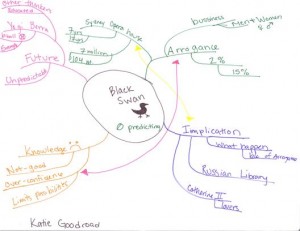An Idea Mapping Success Blogs Weblog
Luther College Idea Mapping Experiment Part 10 Shares Idea Maps 219 Thru 222
11Mar2010 Filed under: Book Reviews, Idea Mapping Example, Mind Mapping Examples Author: Jamie NastThese Idea Maps make 20 examples in this experiment (initiated by Dr. Tim Schweizer in the fall of 2009) following students at Luther College in Decorah, Iowa. The October 23, 2009 posting first introduced this series and and the October 28, 2009 post puts this experiment in context. Read those postings for background or search on “Luther College” in this blog for other examples.
Today’s idea mapping examples come from students Kara Schrapp (top) and Ryan Fett who both provided their reflections on the book Squirrel Inc.: A Fable of Leadership through Storytelling by Stephen Denning in the form of an idea map. Here are Kara’s thoughts about Idea Mapping:
“Idea Mapping wasn’t a hard concept to pick up and do when I’m told to. However, it is a lot harder for me to actually practice it outside of specified homework situations. I have been taking notes one way for so long and have worked hard on perfecting that skill so that switching is difficult. Even though I can see how a mind map would be more organized because it isn’t a list of words I don’t feel like it is more organized, and when taking notes the appearance of them is oddly something that matters to me. Yet even though I don’t mind map on my own time learning the skill has helped me when I am reading material for my classes because I think of it in a way of “how would I mind map this?” which allows me to group information together and find the key points more efficiently than I have in the past even if in the end I still write out my notes on my lined paper.”
Here are Ryan’s thoughts about Idea Mapping:
“Initially I really didn’t like the whole idea of idea mapping. The first few maps I did were really disheartening due to my lack of any artistic abilities whatsoever. After the last few that I have done, however, I think I am getting the hang of it! They really do work better for organizing your ideas and notes on paper, but I feel like they will take a lot of practice and application to get used to using them in your everyday life.”
The next two idea maps come from students Bethany Aschim (The 22 Immutable Laws of Marketing by Al Ries and Jack Trout) and Katie Goodroad (The Black Swan by Nassim Taleb). Here are Bethany’s thoughts about Idea Mapping:
“I really like the whole idea concept of idea mapping, it’s really nice to be able to be creative while taking notes and brainstorming. It was really easy to learn with just the few chapters that we read. It really nice to organize things that I need to do during the week and take notes during a class. I also like that its easy to go back and add small things later, whereas in a regular list of notes there isn’t room to go back and put things in without it being messy.”
Here are Katie’s thoughts about Idea Mapping:
“Mind mapping was challenging for me becase my mind would move to quickly to beable to keep up wtih changing colors and knowing whether to create a different branch. I did like the freedomof being able to let my mind wonder and come up with ideas, but sometimes my mind would wonder to fast.”
Thanks to all who shared their examples!
Remember: If you are a project manager and have either considered taking the PMP exam, are in the process of studying for it, have passed the exam, or gave up on the whole process — this is your chance to share your experience in this survey which takes less than 10 minutes. As a “thank you” please enter the drawing for free Amazon gift cards or an autographed copy of Idea Mapping by Jamie Nast. Full story here.
- Tags: Al Ries, Bethany Aschim, College Students Use Idea Mapping for Better Grades, Idea Mapping Example, Idea Mapping for Study Skills, Jack Trout, Kara Schrapp, Katie Goodroad, Luther College, Mind Mapping Example, Nassim Taleb, Ryan Fett, Squirrel Inc., Stephen Denning, The 22 Immutable Laws of Marketing, The Black Swan, Tim Schweizer
Idea Mapping Blog
The purpose of this blog is to share idea mapping examples and related learning from my Idea Mapping, Memory, Speed Reading, and Certification Workshops. This blog is dedicated to my Certified Idea Mapping Instructors, my clients, Mind Mapping and Idea Mapping practitioners around the globe.




![[Ask]](http://ideamapping.ideamappingsuccess.com/IdeaMappingBlogs/wp-content/plugins/bookmarkify/ask.png)
![[del.icio.us]](http://ideamapping.ideamappingsuccess.com/IdeaMappingBlogs/wp-content/plugins/bookmarkify/delicious.png)
![[Digg]](http://ideamapping.ideamappingsuccess.com/IdeaMappingBlogs/wp-content/plugins/bookmarkify/digg.png)
![[Facebook]](http://ideamapping.ideamappingsuccess.com/IdeaMappingBlogs/wp-content/plugins/bookmarkify/facebook.png)
![[Google]](http://ideamapping.ideamappingsuccess.com/IdeaMappingBlogs/wp-content/plugins/bookmarkify/google.png)
![[MySpace]](http://ideamapping.ideamappingsuccess.com/IdeaMappingBlogs/wp-content/plugins/bookmarkify/myspace.png)
![[Slashdot]](http://ideamapping.ideamappingsuccess.com/IdeaMappingBlogs/wp-content/plugins/bookmarkify/slashdot.png)
![[Sphinn]](http://ideamapping.ideamappingsuccess.com/IdeaMappingBlogs/wp-content/plugins/bookmarkify/sphinn.png)
![[StumbleUpon]](http://ideamapping.ideamappingsuccess.com/IdeaMappingBlogs/wp-content/plugins/bookmarkify/stumbleupon.png)
![[Technorati]](http://ideamapping.ideamappingsuccess.com/IdeaMappingBlogs/wp-content/plugins/bookmarkify/technorati.png)
![[ThisNext]](http://ideamapping.ideamappingsuccess.com/IdeaMappingBlogs/wp-content/plugins/bookmarkify/thisnext.png)
![[Twitter]](http://ideamapping.ideamappingsuccess.com/IdeaMappingBlogs/wp-content/plugins/bookmarkify/twitter.png)
![[Webride]](http://ideamapping.ideamappingsuccess.com/IdeaMappingBlogs/wp-content/plugins/bookmarkify/webride.png)
![[Email]](http://ideamapping.ideamappingsuccess.com/IdeaMappingBlogs/wp-content/plugins/bookmarkify/email.png)
Leave a reply